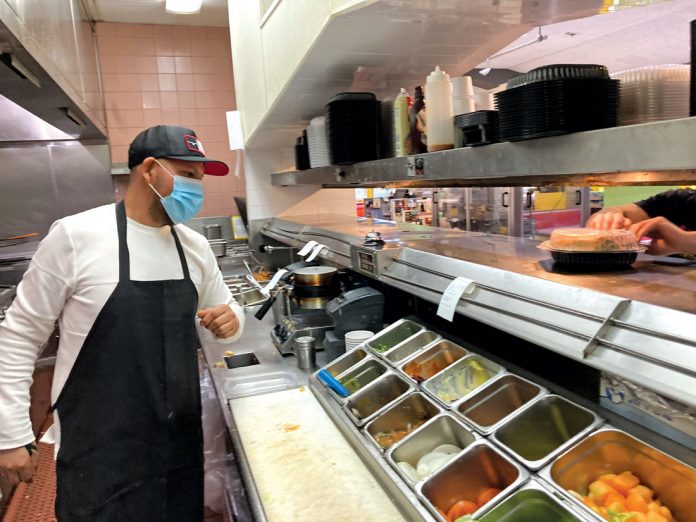Local small business owners are “just waiting it out”—according to Jim Angelopoulos, owner of Yolked Extreme Breakfast in Morgan Hill—instead of trying to predict the next phase of reopening, after state officials on Jan. 8 extended the current Covid-19 stay-at-home order for an indefinite period.
The order, which applies to 11 counties in the Bay Area, means that restaurants must remain closed for both outdoor and indoor dining, but may still provide delivery and takeout food. The shelter-in-place order also continues to prohibit public indoor gatherings and limits indoor retail to 20 percent of a store’s capacity.
Although the extension of December’s stay-at-home order wasn’t a complete surprise to many, small business owners like Angelopoulos are increasingly frustrated and confused about the fluctuating restrictions, which have had corresponding impacts on sales and employment.
Yolked, located at 775 E. Dunne Ave., employed 25 people before the pandemic in 2020; then Angelopoulos cut the restaurant’s staff down to five in March, when public health officials implemented the first Covid-19 shelter-in-place order. Then when outdoor dining opened in the summer, Angelopoulos rehired a full staff and spent $30,000 on a dining patio in front of the restaurant. But now, Yolked is back down to eight employees since the most recent order, which has been in place since a post-Thanksgiving surge of Covid-19 cases throughout the region.
A 5,000-square-foot building with a spacious dining room and plenty of tables, Yolked is designed for on-site family dining, Angelopoulos explained. On a typical Saturday before the pandemic, the restaurant might serve 700 customers daily.
Now, his sales are down by about 50 percent from a year ago. In fact, Angelopoulos’ partnership with Santa Clara County in the World Central Kitchen program that provides meals for senior citizens has been a big help in keeping Yolked afloat.
Angelopoulos also added about $5,000 worth of plastic barriers between tables—a public health protocol for when indoor dining can open again—and an online menu for the first time. He gained about $150,000 from the federal Paycheck Protection Program last year, but those funds have already been spent on payroll, utilities and rent.
The frustration grows as Angelopoulos still can’t even use many of the modifications Yolked has made in response to the new public health and hygiene guidelines. Like many residents who have grown weary of the pandemic, Angelopoulos wonders why activities like outdoor dining are prohibited while large grocery stores may continue to allow crowds of shoppers.
“But right now it doesn’t matter,” Angelopoulos said Jan. 12. “We’re just going by what Mr. (Governor) Gavin Newsom says is good for us.”
He added, “At the end of the day, we just want to open again. We’re just waiting everything out, waiting to see what’s next.”
ICU capacity diminishes
State public health officials on Jan. 8 extended the current public health order because the Bay Area’s Intensive Care Unit bed capacity remains below 15 percent. In Santa Clara County on Jan. 12, ICU capacity was less than 1 percent.
The stay-home order was originally set to expire last week. Currently, there is no end date for the extended stay-at-home order. State officials said the order could be at least partially lifted once the region’s four-week ICU projection shows a capacity of 15 percent or greater. “The state will assess the region’s ICU projections in the coming days and announce a formal decision on whether Bay Area meets criteria to exit the order,” reads the state’s Jan. 8 announcement.
Most other regions in California are subject to the same stay-at-home restrictions, as ICU capacities have all but disappeared in many counties. The current ICU capacity in the San Joaquin Valley—which includes San Benito County—and Southern California regions is 0 percent, according to state data. The Greater Sacramento region is at 9.7 percent ICU capacity, while Northern California is at 35 percent.
Downtown Morgan Hill—a neighborhood filled with dozens of restaurants—has been especially quiet since late December due to the stay-at-home orders. Most downtown establishments continue to serve takeout and delivery food, but have cut their hours as business has slowed to a crawl.
Starting just after Jan. 1, Odeum restaurant has cut its lunch takeout hours to only four days per week, according to owner Sal Calisi. Calisi also owns Prova in downtown Morgan Hill, and between the two restaurants he has laid off more than 30 employees since March 2020.
The City of Morgan Hill, chamber of commerce and downtown association have tried to encourage community members to “buy local” and support small businesses during the pandemic. But Calisi thinks the dining public is starting to feel the pinch as well.
“In the beginning (of the pandemic) guests would come and order takeout—their order was $40 and they give you a $100 bill and say ‘keep it,’” Calisi said. “People were generous, spending a lot of money and tipping a lot just to be supportive. This round, I feel like everyone is beat up, everyone is tired of it.”
Like Angelopoulos, Calisi wonders why restaurants are “singled out” for closure while larger businesses in other industries can remain open. Both restaurateurs think they could safely handle limited capacities for on-site dining, especially outdoors.
“I think every business is essential to somebody,” Calisi said.
Angelopoulos praised the Morgan Hill chamber’s efforts to promote small local businesses during the pandemic. Early on after the first stay-home order in March 2020, the chamber created a Facebook page titled “Morgan Hill Take-Out, Delivery & Outdoor Service Options during Covid-19.” The page has been a big help in allowing restaurant owners to promote their business and offer updates on hours, Angelopoulos said.















